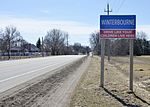Weissenburg, Ontario
Communities in the Regional Municipality of WaterlooUse Canadian English from January 2023Woolwich, Ontario

Weissenburg is an unincorporated rural community in Woolwich Township, Waterloo, Ontario, Canada.Weissenburg is located at the crossroads of Line 86 and Sideroad 16.
Excerpt from the Wikipedia article Weissenburg, Ontario (License: CC BY-SA 3.0, Authors, Images).Weissenburg, Ontario
Line 86, Woolwich
Geographical coordinates (GPS) Address Nearby Places Show on map
Geographical coordinates (GPS)
| Latitude | Longitude |
|---|---|
| N 43.574444444444 ° | E -80.4 ° |
Address
Line 86 5865
N0B 2V0 Woolwich
Ontario, Canada
Open on Google Maps







